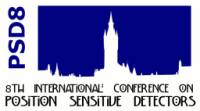Speaker
Harris Kagan
(Ohio State University)
Description
With the commissioning of the LHC expected in 2008, and the LHC upgrades expected in 2012, ATLAS and CMS are planning for detector upgrades which require radiation hard technologies. Chemical Vapor Deposition (CVD) diamond has been used extensively in beam conditions monitors as the innermost detectors in the highest radiation areas of BaBar, Belle and CDF and is now planned for all LHC experiments. This material is now being discussed as an alternate sensor material for use very close to the interaction region of the super LHC where the most extreme radiation conditions will exist. Recently the RD42 collaboration constructed, irradiated and tested polycrystalline and single-crystal chemical vapor deposition diamond detectors to the highest fluences available. In this paper we present beam test results of chemical vapor deposition diamond up to fluences of 1.8 × 10^16 protons/cm2 which shows that both polycrystalline and single-crystal chemical vapor deposition diamonds follow a single damage curve allowing one to extrapolate their performance as a function of dose. We will also present the beam test results of irradiated diamond strip detectors which function quite well after a fluence of 1.5×10^15 p/cm2.
Author
Harris Kagan
(Ohio State University)

